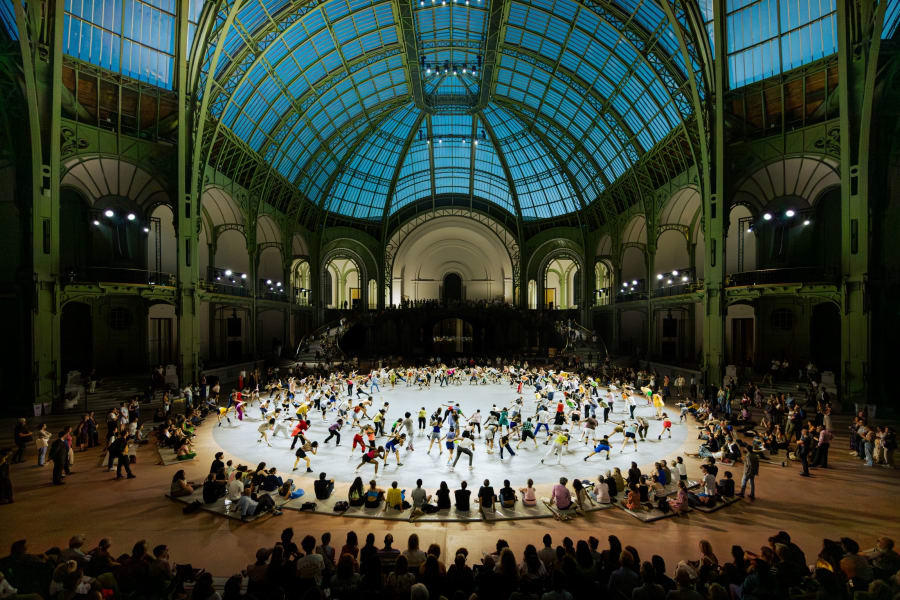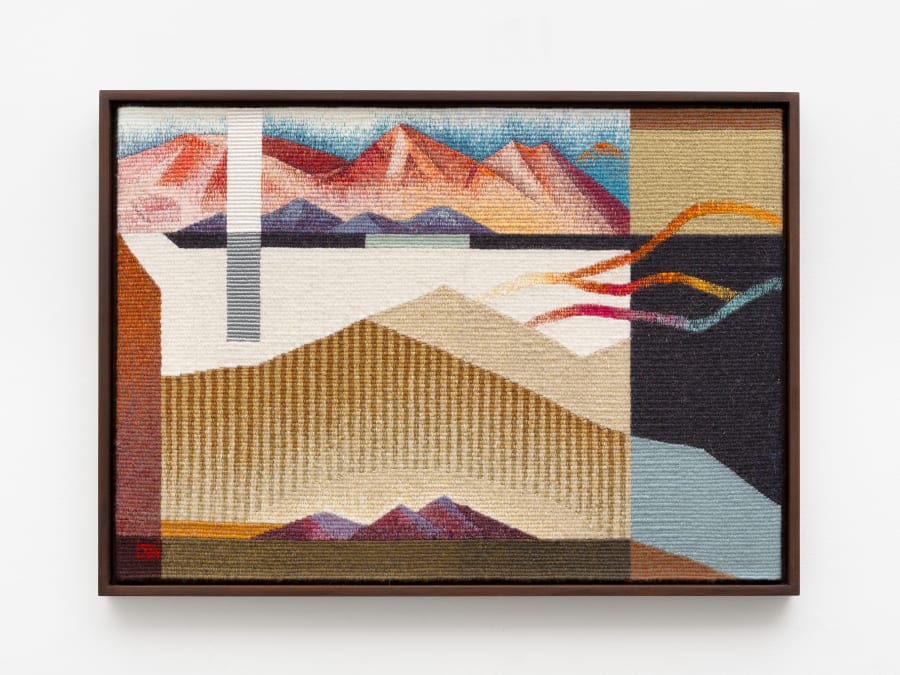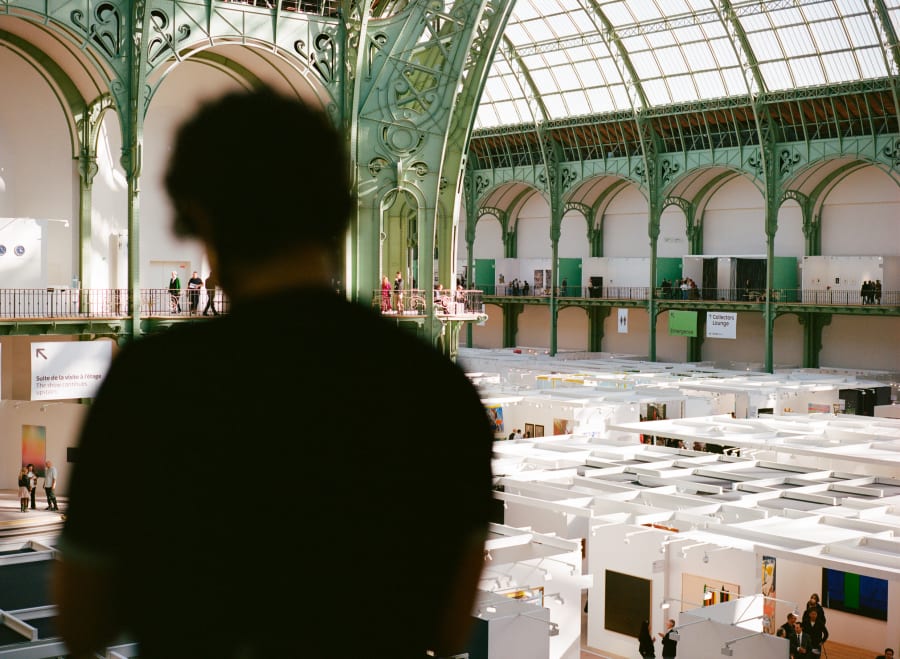Art Basel Paris is only on its fourth edition, and already transformation is in the air: the fair is no longer simply a market place but is also a space for exploration, discovery, and exchange. Through continuous dialogue between galleries, institutions, and different disciplines, Art Basel Paris is redefining what a fair can say about our time. Now fully installed within the recently renovated Grand Palais, Art Basel Paris has a strong base from which to hone its vision. This edition is doubly significant: not only is the fair consolidating its place within its new permanent home, but it is also the last to be led by Delépine, who will take the helm at Lafayette Anticipations in November 2025.
Fresh air beneath the glass
‘In 2022, we had seven months to stage the first edition,’ says Delépine, looking back on these years of constant change. ‘In 2023, we were already preparing our return to the Grand Palais. In 2024, we were up against it because of the Olympics and construction delays...’ In 2025, for the first time, the fair will take over the whole of the restored Grand Palais, utilizing all of its spaces. ‘This is the first “normal” edition,’ he explains. ‘We’re moving beyond the temporary, and at last finding stability.’
This newfound stability has allowed for further refinements: in the selection of galleries, the construction of a narrative, the design of visitor flow. ‘The selection committee has really taken into account the two coexisting areas: the main hall and the first floor which is equally important,’ says Delépine. The key has been to find a balance between a spectacular central area and the significant contributions to be found around the edges. ‘The space dictates everything,’ he explains. ‘We’ve had to stop fantasizing about an ideal space and instead work with what we have, taking the rough with the smooth.’ Quoting Georges Perec, the Art Basel Paris Director notes that from constraint comes freedom.
Why Paris?
This approach chimes with a greater goal: to create a profoundly Parisian fair – not one simply located in Paris. ‘Art Basel Paris isn’t Art Basel in Paris,’ says Delépine. ‘We’ve sought to construct a true identity.’ The French way of doing things hasn’t been an obstacle, but instead has been a strength. ‘Paris has taught Art Basel something,’ he continues. ‘We’ve injected flexibility into a well-oiled machine.’ The Louvre, the Centre des Monuments Nationaux, the Centre Pompidou, the Palais d’Iéna, the Palais de Tokyo, the École des Beaux-Arts have all contributed to the overarching narrative. ‘Paris has never been more desirable. And that creates a sense of shared responsibility.’
Emergence and Premise
The Grand Palais doesn’t merely serve as backdrop to the fair – it plays a defining role. Two sectors in particular embody this spatial impact: Emergence, up above the main hall, and Premise, right at the very heart. In these two areas, the fair abandons hierarchy and finds its true voice.
Located on the balcony, Emergence assumes a symbolic position: It’s a vantage point from which to survey the future. There are sixteen projects mainly staged by galleries participating in the fair for the first time. ‘This is the future!’ declares Delépine. ‘The established galleries of today such as Zwirner, Esther Schipper, neugerriemschneider, were all once young galleries at Liste, Basel’s satellite fair.’ Speaking of the patience and curatorial commitment needed to succeed, he cites (sans titre), founded by Marie Madec, as a prime example. The gallery has been supported by Art Basel Paris since its beginnings, and is now exhibiting in the main sector. ‘This is what we want to encourage: uncompromised development, with galleries growing over time, without yielding to fashion.’ Petrine, Exo Exo, ROH Projects, and Sophie Tappeiner tell a similar story. Some galleries are returning; others are discovering Paris for the first time.
Where Emergence looks forward, Premise looks back. Created in 2024, this sector challenges the linearity of history. It hosts works from any time before 1900, but always presents them within a contemporary framework, thereby juxtaposing art from different periods. ‘In Premise definitions are abolished,’ explains Delépine. ‘Here we examine the very ideas of artwork, exhibition, and storytelling.’ Thus, Marie Bracquemond, a long-overlooked artist, is given her due by Pauline Pavec; Lee ShinJa (Tina Kim Gallery) explore the infinite possibilities of textiles; Lucia Moholy’s visions resonate with those of Liz Deschenes (Kadel Wilborn); Janet Olivia Henry (Gordon Robichaux and STARS) unfolds her political dioramas alongside artists like Emily Kam Kngwarreye (Château Shatto) and Hector Hyppolite (The Gallery of Everything), some of whose works come from the collection of André Breton.
Thus, Emergence and Premise represent a porous system: two ways of thinking about exhibitions, two ways of thinking about time. One is about discovery, the other speaks to persistence. One illuminates what is to come, the other gives voice to what is yet to have its day. Both affirm one thing: the fair is a space to share and rethink ideas.
The city as keyhole to the world
This expansive approach extends beyond the Grand Palais. The Public Program remains a key element of the project as a whole. In 2025, for the second consecutive year, Miu Miu is the Public Program Official Partner. In 2024, the house presented ‘Tales & Tellers’, a project by Goshka Macuga, centered on feminine voices, it combined archives and fiction with manifesto. This year’s venture, once again at the Palais d’Iéna, sees Helen Marten, winner of the 2016 Turner Prize, propose a blend of fashion, art, and narrative, that resonates with luxury codes and contemporary frameworks.
Overall, the Public Program unfolds across several institutions and key venues throughout the city. The area around Avenue Winston Churchill will be home to monumental works by Arlene Shechet, Vojtěch Kovařík, and Thomas Houseago. The Petit Palais will host Julius von Bismarck, whose disjointed giraffe strikes up a dialogue with a statue of Bismarck, in a mechanical staging of national concerns.
At the Hôtel de la Marine, Joël Andrianomearisoa will occupy the courtyard with an installation based around memory. At Place Vendôme, Kermit the Frog, Even (2018-2024), Alex Da Corte’s monumental inflatable will pay homage to Macy’s 1991 Thanksgiving Parade in New York. Over at the Institut de France, Ugo Rondinone will take over the forecourt; at the Chapelle des Beaux-Arts, Harry Nuriev will activate a participatory project centered around bartering and objects. At the Musée national Eugène-Delacroix, Nate Lowman will interrogate the artistic legacy of the eponymous artist and at the Cité de l’Architecture, Fabienne Verdier, Galerie Lelong, and Waddington Custot will collaborate on a monumental installation, curated by Matthieu Poirier.
Last year, the Oh La La! initiative was introduced to the fair, the idea being for rehung booths to breathe fresh life into presentations after the VIP days, with freer, sometimes more radical installations. For 2025, the artistic direction has been entrusted to Loïc Prigent, a mischievous observer of fashion and a chronicler of trends in taste. Expect art, style and design to unite under the title ‘à la mode’.
‘The fair is not a museum, instead it captures what’s happening in art in real time,’ explains Delépine. At the Petit Palais, the Conversations program will host Tyler Mitchell (whose exhibition at the Maison Européenne de la Photographie opens at the same time), Frida Escobedo, Kiddy Smile, and Chris Dercon. There is also a day guest-curated by Edward Enninful, the former editor-in-chief of Vogue UK and co-founder of the media and entertainment company EE72.
This cross-fertilization between disciplines finds its true home in Paris. As a hub, the city is at once elegant and rough, somewhere that allows contemporary art to remain radical without losing its audience. ‘Paris makes us do things differently,’ says Delépine. ‘It calls for intelligence, an appetite for risk, and a certain idea of freedom.’
Fair as conversation
‘Gallerists are conduits,’ concludes Delépine. ‘Our responsibility is to offer them a place where stories can unfold.’ The fair is a space for dialogue, a place to be challenged, a moment of sharing. This fourth edition is the most accomplished yet. ‘I hope that when you enter the Grand Palais, you’ll understand what the fair is trying to do. It’s not a trade show. It’s a conversation.’
Art Basel Paris 2025 takes place from October 24 to 26. Get your tickets here.
Marc Beyney-Sonier is a journalist based in Paris.
English translation: Art Basel.
Published on September 17, 2025.
Caption for header image: View of Art Basel Paris 2024.
Caption for footer image: View of the Grand Palais during Art Basel Paris 2024.


